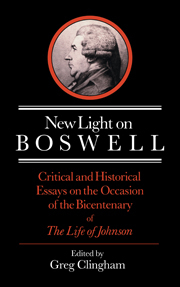 New Light on Boswell
New Light on Boswell Book contents
- Frontmatter
- Contents
- Notes on contributors
- Preface
- Acknowledgements
- Abbreviations
- 1 Introduction: Boswell's ambiguities
- Part I BOSWELL AND EIGHTEENTH-CENTURY SCOTTISH CULTURE
- Part II CONTEXTS FOR THE LIFE OF JOHNSON
- Part III THE LIFE OF JOHNSON RECONSIDERED
- 10 The originality of Boswell's version of Johnson's quarrel with Lord Chesterfield
- 11 Self-restraint and self-display in the authorial comments in the Life of Johnson
- 12 Johnson's conversation in Boswell's Life of Johnson
- 13 Remembering the hero in Boswell's Life of Johnson
- 14 Truth and artifice in Boswell's Life of Johnson
- Index
10 - The originality of Boswell's version of Johnson's quarrel with Lord Chesterfield
Published online by Cambridge University Press: 28 October 2009
- Frontmatter
- Contents
- Notes on contributors
- Preface
- Acknowledgements
- Abbreviations
- 1 Introduction: Boswell's ambiguities
- Part I BOSWELL AND EIGHTEENTH-CENTURY SCOTTISH CULTURE
- Part II CONTEXTS FOR THE LIFE OF JOHNSON
- Part III THE LIFE OF JOHNSON RECONSIDERED
- 10 The originality of Boswell's version of Johnson's quarrel with Lord Chesterfield
- 11 Self-restraint and self-display in the authorial comments in the Life of Johnson
- 12 Johnson's conversation in Boswell's Life of Johnson
- 13 Remembering the hero in Boswell's Life of Johnson
- 14 Truth and artifice in Boswell's Life of Johnson
- Index
Summary
Johnson's letter to Lord Chesterfield is certainly one of the more memorable moments in Boswell's Life. It lingers on in the public memory and has become an indelible part of our inherited picture of Johnson. The sequence of events leading up to the publication of the Life of Johnson in 1791 suggests that this began to happen well before the biography was published. In his Journal of a Tour to the Hebrides, published at the beginning of October 1785, Boswell had included a note giving the public notice that Johnson had related to him “some particulars” “concerning his throwing off Lord Chesterfield's patronage,” and that he was reserving these for the Life which was to be published later. In 1790 Boswell had the letter to Lord Chesterfield printed separately, apparently as a foretaste of what he would provide for the public in the full Life which was to be published the following year.
A question necessarily arises here: why did Boswell believe the Chesterfield material was so important? The answer to that seems to come in many parts. Above all, Boswell seems to have believed that the quarrel with Lord Chesterfield brought himself and us into contact with something essential in Johnson's character. It was also, as far as he was concerned, a crucial event in the development of Johnson's public personality. The letter to Chester-field was, at least in symbolic terms, Johnson's liberation, a key moment when he stood up for himself and so came of age, passing psychologically from dependence to independence.
- Type
- Chapter
- Information
- New Light on BoswellCritical and Historical Essays on the Occasion of the Bicententary of the 'Life' of Johnson, pp. 143 - 161Publisher: Cambridge University PressPrint publication year: 1991
